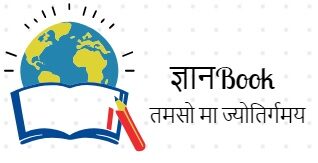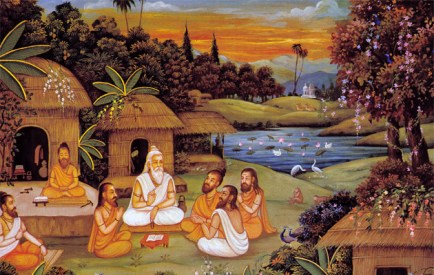Vedic Literature
Vedic Literature comprises of four literary productions:
1. The Samhitas or Vedas
2. The Brahamans
3. The Aranyakas
4. The Upanishads.
>> The most important of Vedic Literature are Vedas. Vedas are called Apaurasheya i.e. not created by man but God-gifted and Nitya i.e. existing in all eternity.
>> There are four Vedas- Rig Veda, Sama Veda, Yajur Veda and Atharva Veda. The first three Vedas are jointly called Vedatrayi i.e. trio of Vedas.
>> Of the four Vedas, the Rig Veda (Collection of lyrics) is the oldest text in the world, and therefore, is also known as ‘the first testament of mankind’, The Rig Veda contains 1028 hymns, divided into 10 mandalas.
Six mandalas (from 2nd to 7th mandalas) are called Gotra/Vamsha Mandalas (Kula Granth). The 1st and 10th mandalas are said to have been added later. The 10th mandala contains the famous Purushasukta which explains the 4 Varnas – Brahmana, Kshatriya, Vaishya and Shudra. The hymns of Rig Veda were recited by Hotri.
>> The Sama Veda (book of chants) had 1549 hymns. All hymns (excluding 75) were taken from the Rig Veda. The hymns of the Sama Veda were recited by Udgatri. This Veda is important for Indian music.
>> The Yajur Veda (book of sacrificial prayers) is a ritual veda. Its hymns were recited by Adhvaryus. It is divided into two parts-Krishna Yajur Veda and Shukla Yajur Veda. In contrast to the first two which are in verse entirely, this one is in both verse and prose.
>> The Atharva Veda (book of magical formulae), the fourth and the last one, contains charms and spells to ward off evils and diseases.
>> The Brahmans explain the hymns of the Vedas. They are written in prose and ritualistic in nature. Brahma means ‘sacrifice’. The various sacrifices and rituals have been elaborately discussed in the Brahamanas. Every Veda has several Brahamanas attached to it:

>> The word Aranya means ‘the forest’. The ‘forest texts’ were called Aranyaka, because they were written mainly for the hermits and the students living in jungles. The Aranyaka are the concluding portions of the Brahamanas.
>> The Upanishadas are philosophical texts. They are generally called Vedanta, as they came towards the end of the Veda. There are 108 Upanishadas. Vrihadaranyaka is the oldest Upanishada.
Literature of Vedic Tradition (600 BC-600 AD)
Literature of Vedic Tradition (Smriti i.e. rememberance literature) comprises of 6 literary works: 1. Vedangas/ Sutras 2. Smritis Dharmashastras 3. Mahakavyas (Epics) 4. Puranas 5. Upvedas 6. Shad-Dharshanas.
There are six Vedangas:
1. Shiksha (Phonetics): ‘Pratishakhya’-the oldest text on phonetics.
2. Kalpa Sutras (Rituals):a.Shrauta Sutras/Shulva Sutras-deal with the sacrifices,
b. Grihya Sutras-deal with family ceremonies, c. Dharma Sutras-deal with Varnas, Ashramas etc.
3. Vyakarana(Grammar): ‘Ashtadyayi’ (Panini)-the oldest grammar of the word.
4. Nirukta (Etymology): ‘Nirukta’ (Yask) based on ‘Nighantu’ (Kashyap)-a collection of difficult vedic words-(‘Nighantu’-the oldest word-collection of the world; ‘Nirukta’-the oldest dictionary of the world).
5. Chhanda (Metrics): ‘Chhandasutras’ (Pingal)-famous text.
6. Jyotisha (Astronomy): ‘Vedanga Jyotisha’ (Lagadh Muni)-the oldest Jyotisha text.
>> There are six famous Smritis:
(i) Manu Smriti (Pre-Gupta Period)-the oldest Smriti text; Commentators : Vishwarupa, Meghatithi, Gobindraj, Kulluk Bhatt.
(ii) Yajnvalkya Smriti (Pre-Gupta Period)- Commentators: Vishwarupa, Jimutvahan (‘Daybhag’), Vijnyaneshwar, (‘Mitakshara’) Apararka (a king of Shilahar Dynasty)
(iii) Narad Smriti (Gupta period)
(iv) Parashara Smriti (Gupta period)
(v) Brihaspati Smriti (Gupta period)
(vi) Katyayana Smriti (Gupta period)
There are mainly two Mahakavyas (Epics):
- The Ramayana (Valmiki) : It is known as “Adi Kavya” (the oldest epic of the world). At present, it consists of 24,000 shlokas i.e. verses (Originally 6,000, Later – 12,000, Finally – 24,000) in 7 Kandas i.e. sections. 1st and 7th Kandas were the latest additions to the Ramayana.
- The Mahabharata (Ved Vyasa): The longest epic of the world. At present, it consists of 1,00,000 shlokas i.e. verses (Originally-8,800-Jay Samhita, Later-24,000-Chaturvinshati Sahastri Samhita/Bharata, Finally-1,00,000Shatasahastri Samhita/Maha Bharata) in 18 Parvans i.e. chapters, plus the Harivamsa supplement. Bhagavad Gita is extracted from Bihshma Parvan of Mahabharata. Shanti Parvan is the largest parvan (chapter) of the Mahabarata.
>> The Purana means ‘the old’. There are 18 famous ‘Puranas’. The Matsya Purana is the oldest Puranic text. The other important Puranas are the Bhagavata, The Vishnu, The Vayu and The Brahamnda.
>> The Upavedas (the auxiliary vedas) were traditionally associated with vedas :

Rig Vedic/Early Vedic Period (1500 BC-1000 BC)
Geographical Area
>> From the names of rivers, mountains (Himvant i.e. Himalaya, Munjavant i.e. Hindukush) and ocean in Rig Veda we have a clear idea of the geographical area in which Rigvedic people lived.
>> Rig Veda mentions 40 rivers. The Rigvedic Name Modern Name Region
Nadisukta hymn of the Rig Veda mentions 21 rivers which include the Ganges in the east and the Kubha (Kabul) in the west.

>> Rigvedic people, who called themselves Aryans, were confined in the area which came to be known as Sapta Sindhu i.e. land of seven rives. Sapta Sindhu comprises Sindhu and their five tributaries- Vitasta, Asikani, Vipas, Parushni & Sutudri and Saraswati.
The Dasrajan War (The Battle of Ten Kings)
According to Rig Veda, the famous Dasrajan war was the internecine war of the Aryans. The Dasrajan war gives names of ten kings who participated in a war against Sudas who was Bharata king of Tritsus family. The ten kings were of the states of Purus, Yadus, Turvasas, Anus and Druhyus along with five others viz. Alinas, Pakhtas, Bhalanas, Sibis and Vishanins. The battle was fought on the bank of Parushni (Ravi) in which Sudas emerged victorious
Polity
>> The Kula (the family) was the basis of both social and political organisations.
Above the Kula were the Grama, the Vis, the Jana and the Rashtra. A group of Kula (families) formed a Grama (the village) and so on.
>> Very little is known about ministers of Unit Head the king. The Purohita or domestic priest was the first ranking official. Other important officials were Senani (army chief) and Gramani (head of village).
>> The army consisted of foot-soldiers and charioteers. Wood, stone, bone and metals were used in weapons. Arrows were tipped with points of metal or poisoned horn. References are made to the moving fort (Purcharishnu) and a machine for assaulting strongholds.
>> Rig Veda speaks of assemblies such as the Sabha, Samiti, Vidath, Gana. Sabha was committee of few privileged and important individuals. Two popular assemblies, Sabha and Samiti, acted as checks on the arbitrary rule of kings. Later Vedas record that the Sabha functioned as a court of justice.
Society
>> The Rigvedic society comprised four varnas, namely Brahmana, Kshatriya, Vaisya and Shudra.
>> Teachers and priests were called Brahamanas, rulers and administrators were called Kshatriyas, farmers, merchants and bankers were called Vaishyas, and artisans and labourers were reckoned as Shudras.
>> Members of the same family took to different professions and belonged to different varnas as well illustrated by a hymn of the Rig Veda. In this hymn a person says: ‘I am a singer; my father is a physician, my mother is a grinder of corn.’
>> A widow could marry the younger brother of her deceased husband (Niyoga).
>> Milk and its products-curd, butter and ghee-formed an important part of the diet. There is also the mention of grain cooked with milk (Kshirapakamodanam).
>> The cow was already deemed Aghanya i.e. not to be killed. Rig Veda prescribes a penalty of death or expulsion from the kingdom to those who kill or injure cows.
Religion
>> There were nearly 33 Gods. Later day tradition classified them into 3 categories of terrestrial (prithvisthana), aerial or intermediate (antarikshasthana) and celestial (dyusthana) god.
1. Terrestrial (Prithvisthaniya): Prithivi, Agni, Soma, Brihaspati and rivers.
2. Aerial/Intermediate (Antarikshasthaniya): Indra, Rudra, Vayu-Vata, Parjanya.
3. Celestial (Dyusthaniya): Daus, Surya (In 5 forms : Surya, Savitri, Mitra, Pushan, Vishnu), Varuna, Aditi, Usha and Asvin.
>> Indra, Agni and Varuna were the most popular deities of Rigvedic Aryans.
Indra or Purandara (destroyer of fort): The most important god (250 Rigvedic hymns are devoted to him); who played the role of warlord and was considered to be the rain god.
Agni: The second most important god (200 Rigvedic hymns are devoted to him); fire god was considered to be the intermediary between the gods and the people.
Varuna: Personified water; was supposed to uphold ‘Rita’ or the natural order (‘Ritasyagopa’).
Surya (Sun) was worshiped in 5 forms : Surya, Savitri, Mitra, Pushan and Vishnu.
Surya (Sun) : God who used to drive daily across the sky in his chariot driven by seven horses.
Savitri (the god of light): The famous Gayatri Mantra is addressed to her.
Mitra: A solar god.
Pushan: The god of marriage; main function-guarding of roads, herdsmen and straying cattle.
Vishnu: A god which covered earth in three steps (Upakrama).
>> Soma: Originally a plant producing a potent drink during courses of Agnishtoma sacrifice, could be hemp / bhang, called king of plants; identified later with the moon. The 9th mandala of Rig Veda, which contains 114 hymns, is attributed to the Soma. That’s why it is called ‘the Soma Mandala‘.
>> Other Gods/ Goddesses: Rudra (the god of animals), Dyaus (the oldest god and the father of the world), Yama (the god of death). Ashwin/ Nastya (the god of health, youth and immortality); Aditi (the great mother of gods), Sindhu (river goddess).
>> Their religion primarily consisted of the worship of gods with a simple ceremonial known as Yajna or sacrifice. Sacrifices consisted of offerings of milk, ghee, grain, flesh and soma.
Later Vedic Period : 1000 BC – 600 BC
Geographical Area
>> During the later Vedic Period, the Aryan settlements covered virtually the whole of Northern India -Aryavarta
>> The centre of culture now shifted from Saraswati to Ganges (Madhya desa).
>> There was mention of more rivers such as Narmada, Sadanira (modern Gandak), Chambal etc.
>> The expansion of people towards the east is indicated in a legend of Satapatha Brahamana – how Videha Madhava migrated from the Saraswati region, crossed Sadanira and came to the land of Videha (modern Tirhut). “He (Agni) then went burning along the earth towards the east, and Gotama Rahugana (the priest) and Videgh Mathava followed after him.” – Satapatha Brahamana
>> Emergence of Janapadas-Kuru (Combination of Purus and Bharatas), Panchala (Combination of Turvashas and Krivis), Kashi etc. in Doab region.
>> Reference to the territorial divisions the later Vedas gives three broad divisions of India, viz. Aryavarta (Northern India), Madhya desa (Central India) and Dakhinapath (Southern India).
Polity
>> In Taittariya Brahmana we notice the theory of the divine origin of kingship.
>> The governmental machinery became more elaborate than before, as a sequel to the growth of the power of the king. New civil functionaries, besides the only civil functionary of the Rigvedic period the purohita came into existence. These were: the Bhagadudha (Collector of taxes), the Suta/ Sarathi (the Royal herald or Charioteer), the Khasttri (Chamberlain), the Akshavapa (Courier).
>> The period also saw the beginning of a regular system of provincial government. Thus, we find Sthapati being entrusted with the duty of administering outlying areas occupied by the aboriginals and Satapati being put over a group of one hundred villages. Adhikrita was the village official. Ugras, mentioned in the Upanishada, was probably a police official.
>> The popular control over the affairs of the kingdom was exercised through Sabha and Samiti, as in the Rigvedic period. Vidatha had completely disappeared by now.
Society
>> As the time passed by Yajnas became elaborate and complicated ceremonial leading to the emergence of learned men known as Brahmanas.
>> And as the Aryans expanded to the east and south, group of people known as Kshatriyas emerged to conquer territories and administer them. The remaining Aryans formed a separate class known as Vaishyas, a word derived from Vis meaning ‘people’. The non-Aryan formed the fourth class known as Shudras.
>> The institution of Gotra i.e. the clan appeared in later Vedic Period.
>> The earliest reference to the 4 Ashramas (the stages of life)-Brahmacharya, Grihastha, Vanprastha and Sanyasa-is found in the Jabala Upanishad. The Ashrama system was formed to attain 4 Purusharthas (Dharma, Artha, Kama and Moksha).
>> The status of women declined. According to Aitareya Brahamana a daughter is the sources of misery but a son is the protector of family.
>> According to Maitrayani Samhita there are three evils-liquor, woman and dice.
>> Yajnavalkya-Gargi dialogue (Vrihadarnyaka Upanishada) indicates that some women had got higher education.
Types of Hindu Marriage (Vivaha):

Religion
>> The earlier divinites Indra and Agni were relegated into the background while Prajapati (creator of the Universe, later known as Brahma), Vishnu (Patron god of Aryans) and Rudra (God of animals, later identified with Shiva/Mahesha) rose in prominence. Now Prajapati became supreme God.
>> Pushana, who protected cattle now became the god of Shudras.
>> Brihadaranyaka Upanishada was first the work to give the doctrine of transmigration (Punarjanma/Samsara-chakra) and deeds (Karma).
>> The early simple ceremonial of Rigvedic Period gave place to elaborate sacrifices requiring the services of as many as 17 priests. In the later Vedas and Brahamanas sacrifices (Yajnas) came into prominence.
There were two varieties of sacrifices-
1. Laghuyajnas (Simple/Private Sacrifices): Performed by householder e.g. Pancha Mahayajna, Agnihotra, Darsha Yajna (on Amavasya i.e. on the last day of the dark fortnight), Purnamasa Yajna (on Purnima i.e. on the day of full moon) etc.
2. Mahayajnas (Grand / Royal Sacrifices): Sacrifices that could only be undertaken by an aristocratic and wealthy man and the king.
- Rajasuya Yajna: Royal consecration, which in its full form comprised a series of sacrifices lasting over a year. In later days it was replaced by simplified Abhisheka i.e. anointment.
- Vajapeya Yajna: Drink of strength, which lasted for a period of seventeen days upto full one year.
- Asvamedha Yajna: Horse sacrifice, which lasted for three days.
- Agnishtoma Yajna: Sacrifice of animals dedicated to Agni, which lasted one day, although Yajnika (performer of Yajna) and his wife spent ascetic life for a year before Yajna. On the occasion of the this Yajna, soma rasa was consumed.
Towards the end of the Vedic Period, there was the emergence of a strong reaction against cults, rituals and priestly domination; Reflection of this mood is found in the Upanishadas.
Featured Image Courtesy: https://shorturl.at/oxDKL



